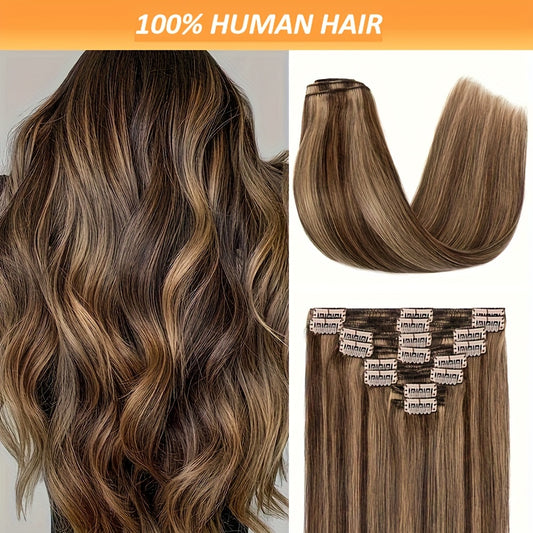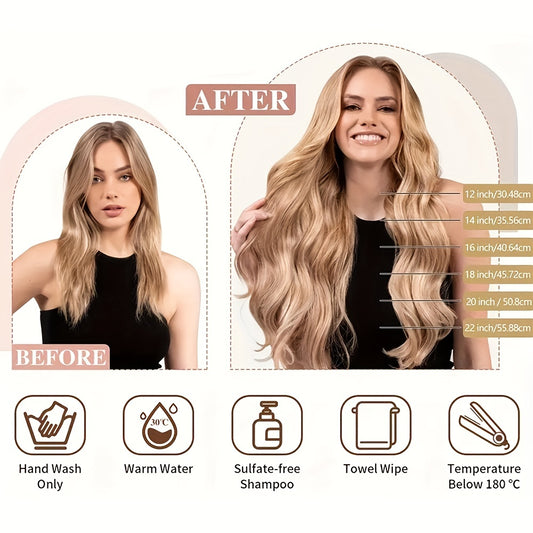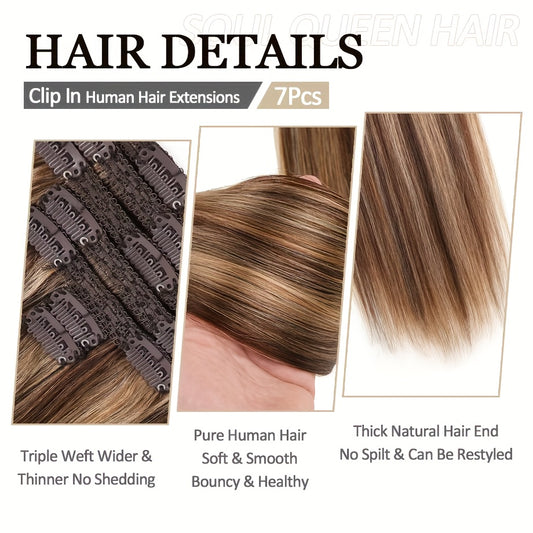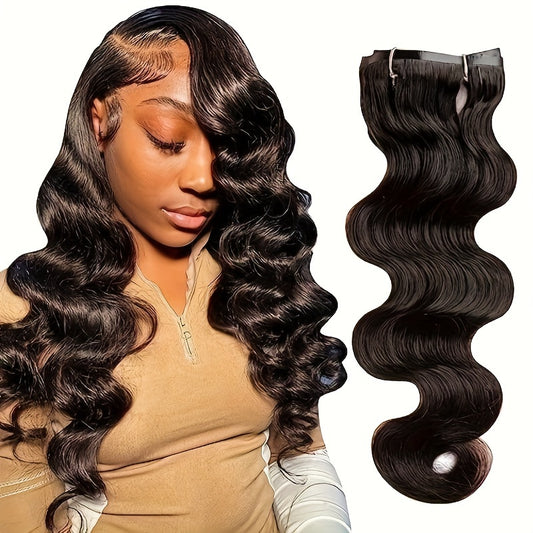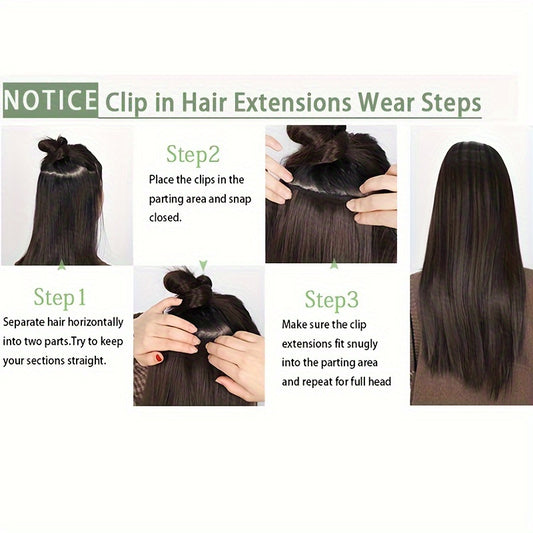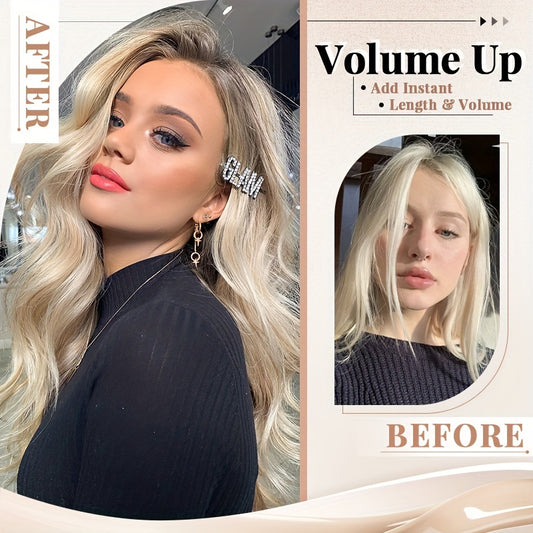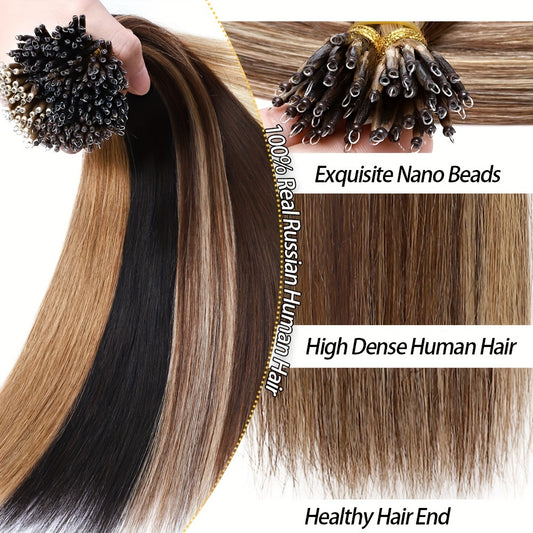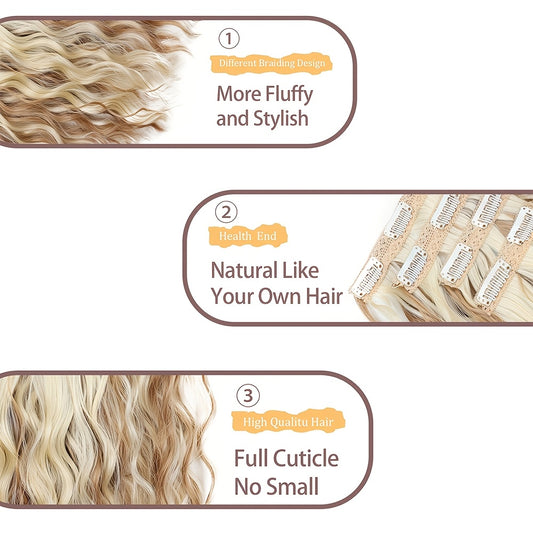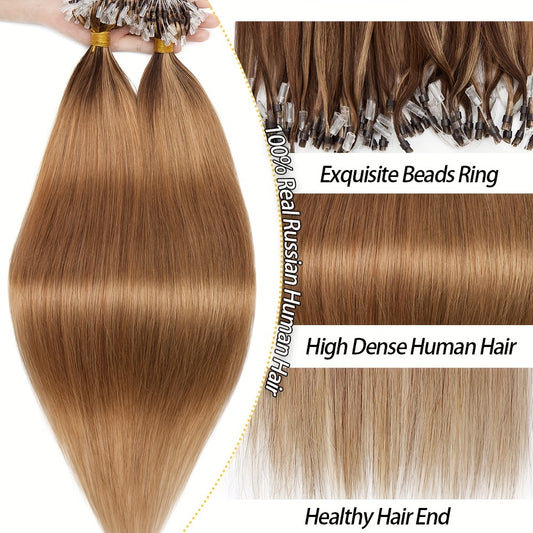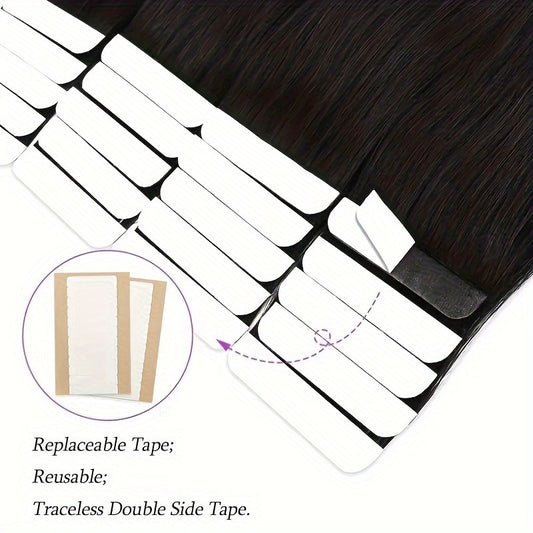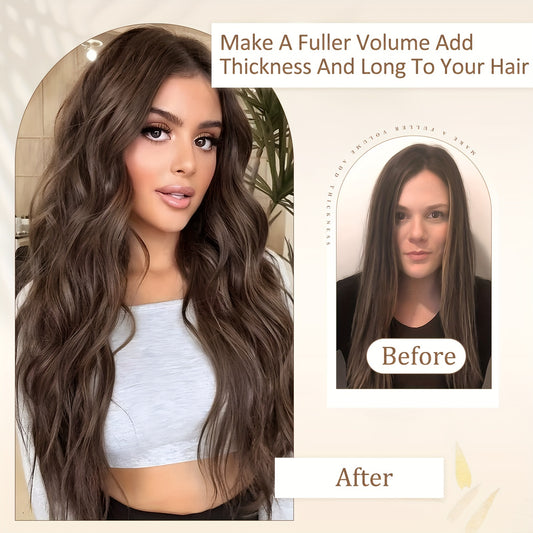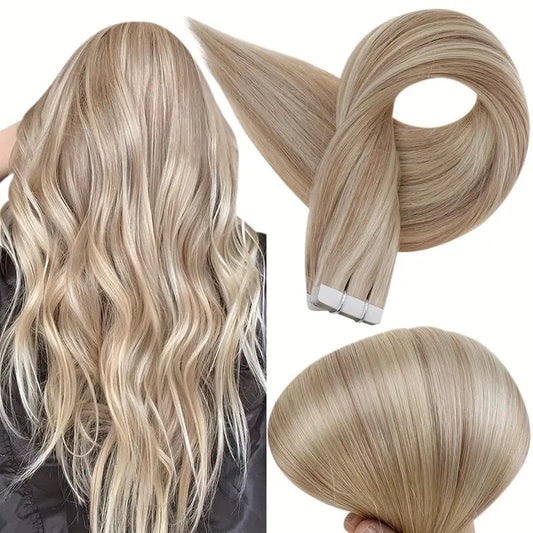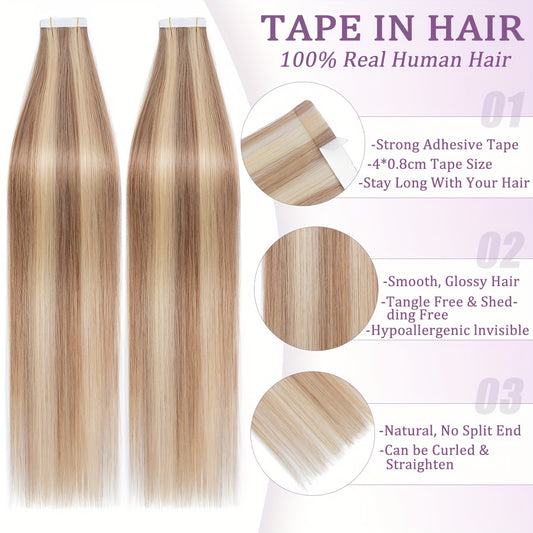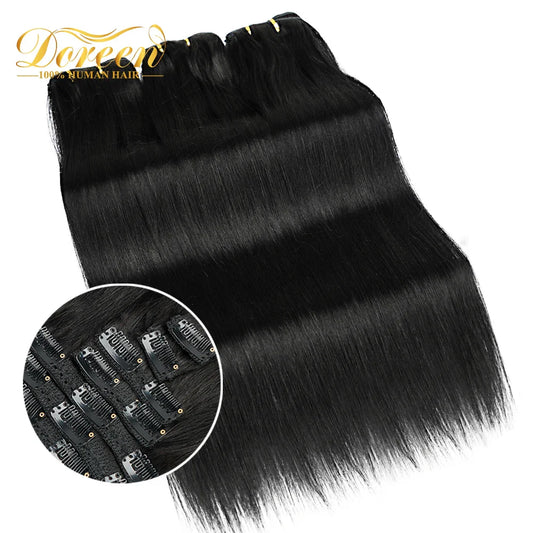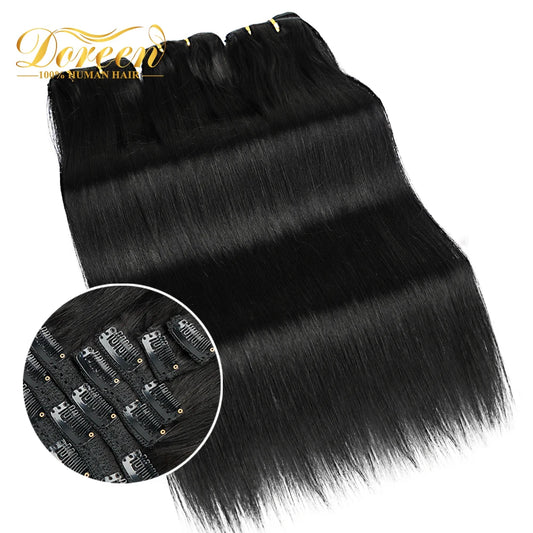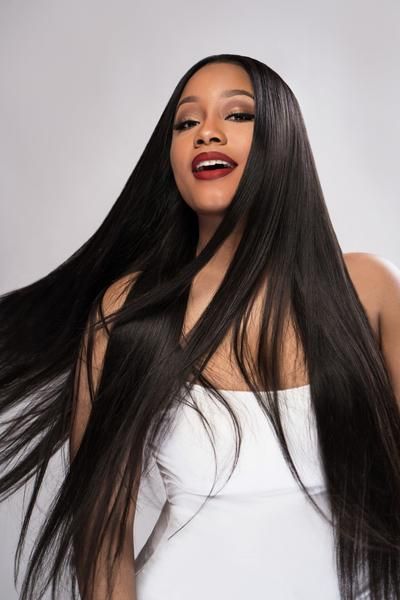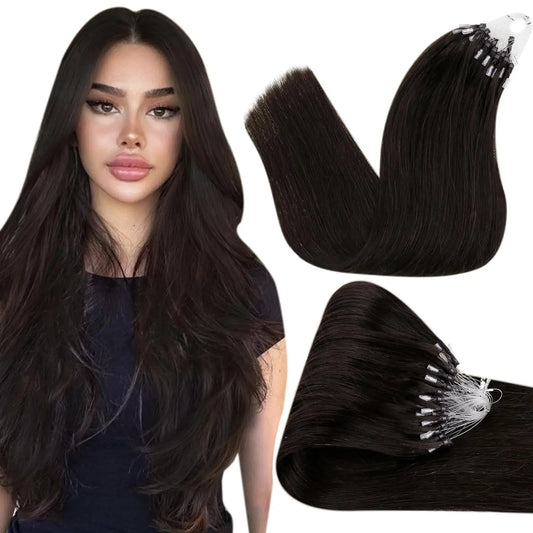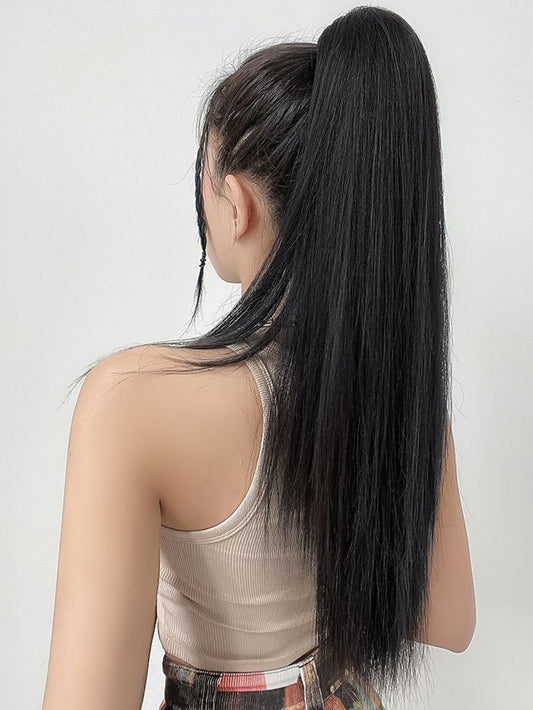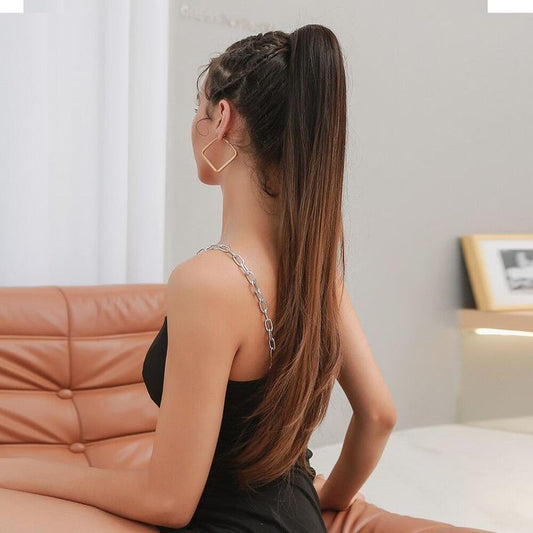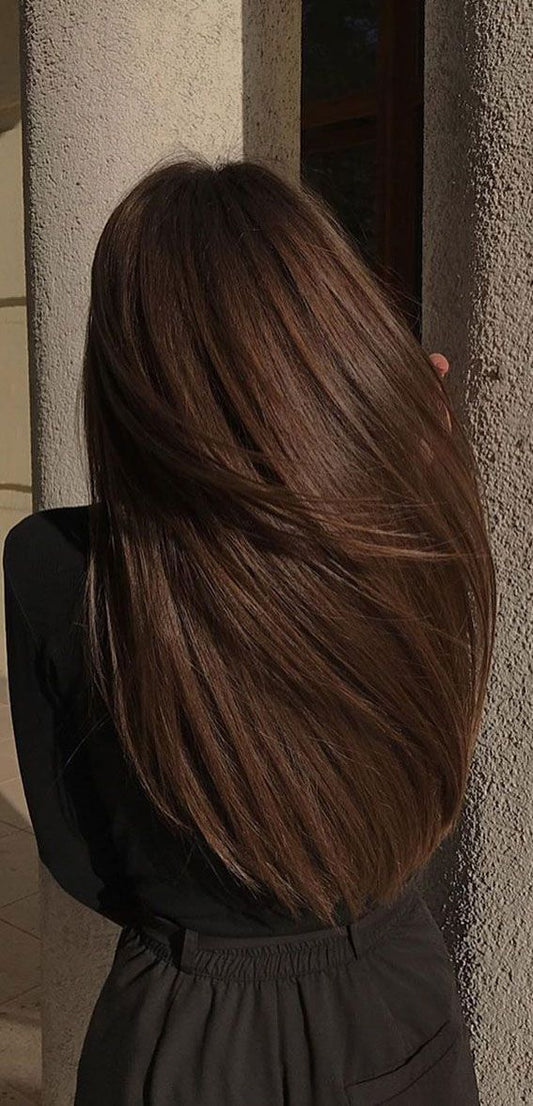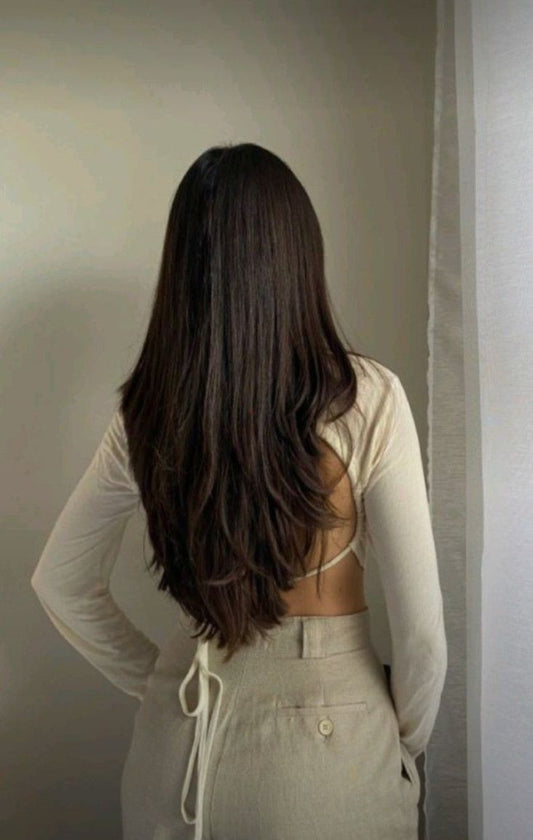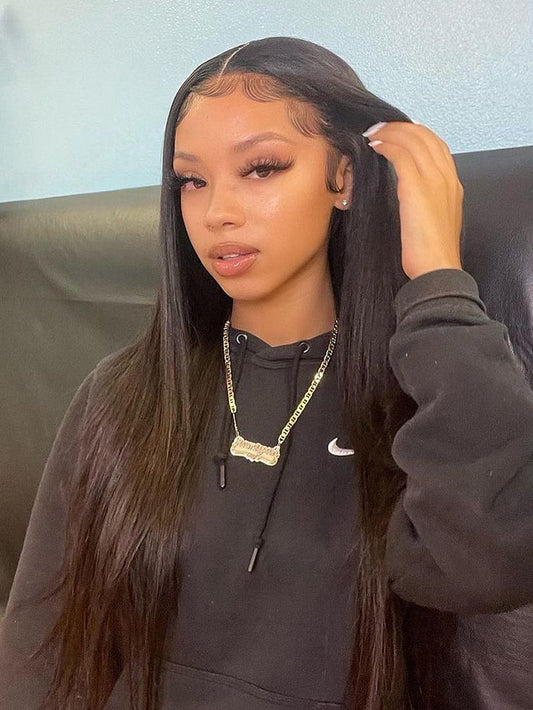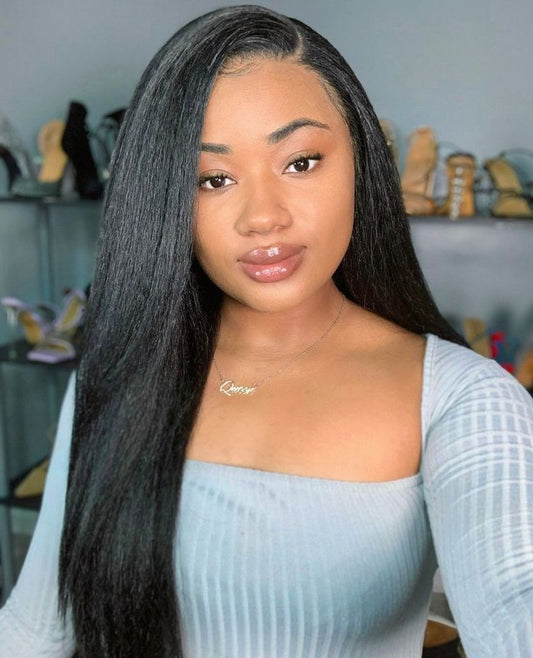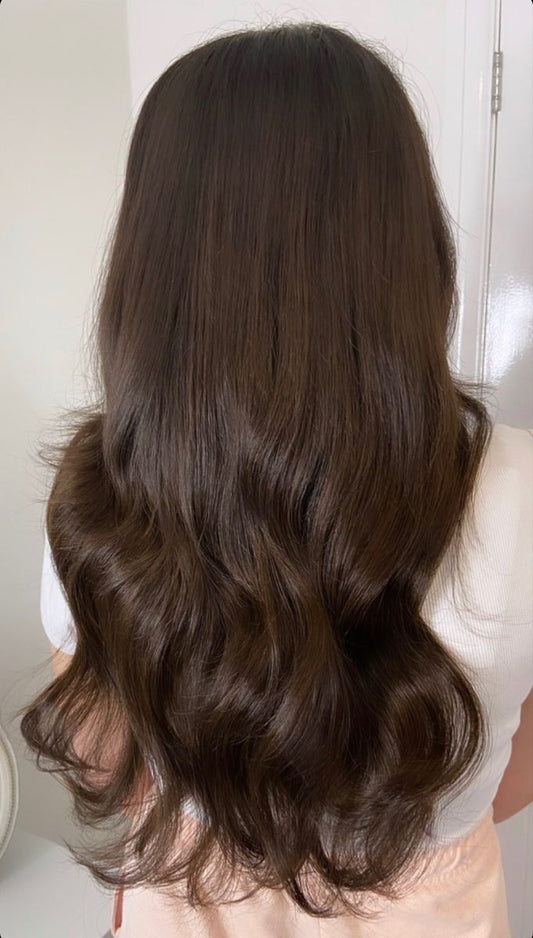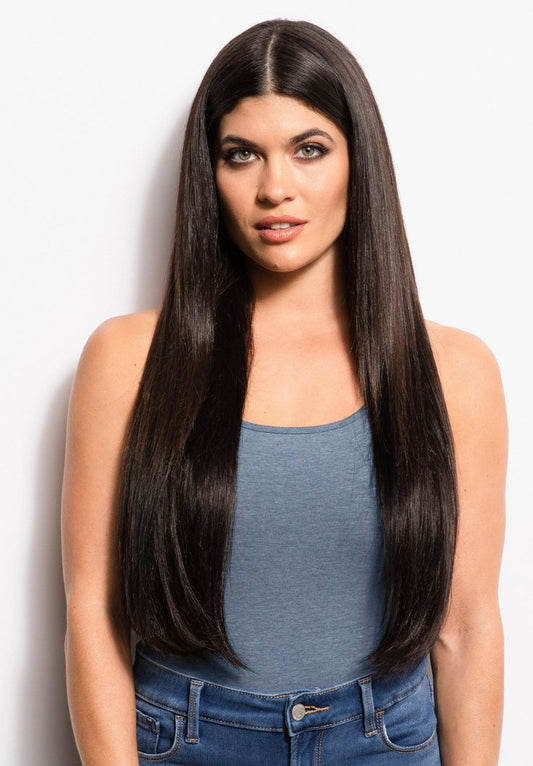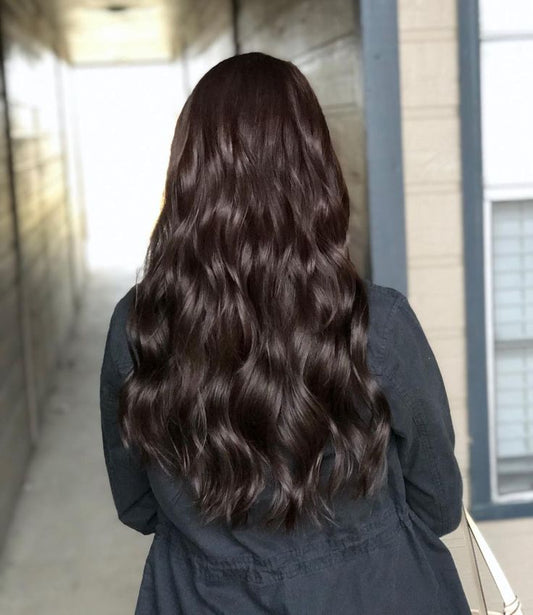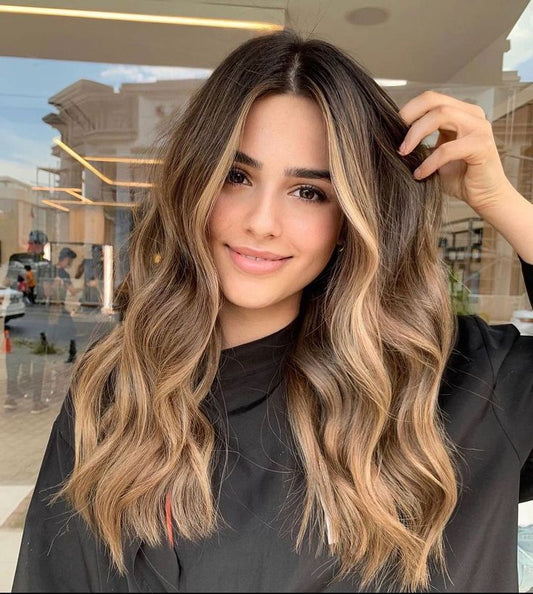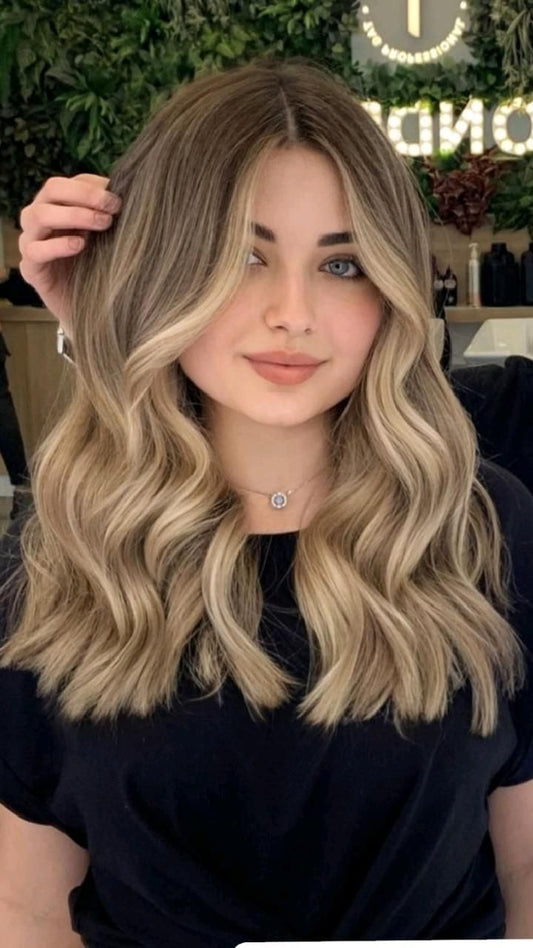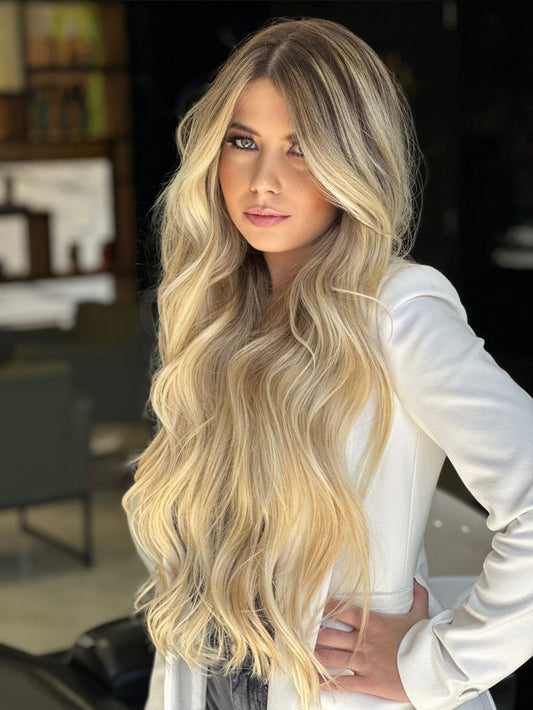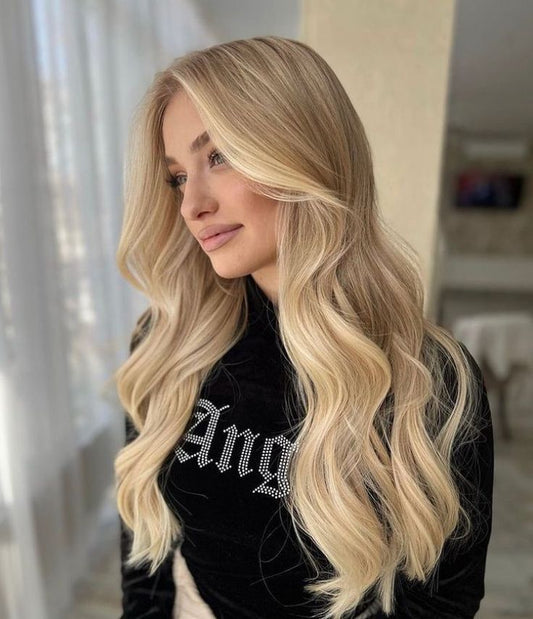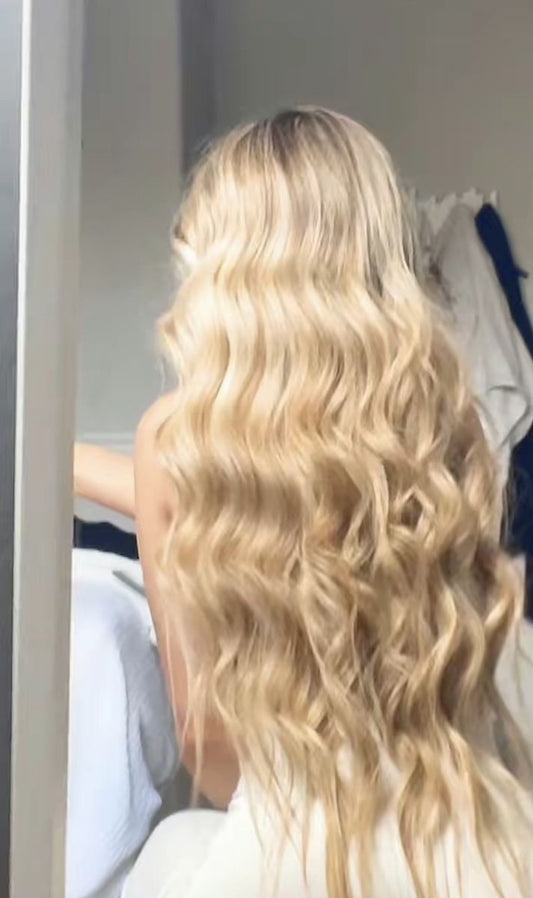About 16 Inch Hair Extensions
Who this length serves best?
Wearers with natural hair from shoulder to collarbone gain a visible length increase plus a wider perimeter that stabilizes curls and blowouts. Fine and medium strands benefit from the additional mass, turning soft bends into styles that hold shape through the day. Those who appear on camera prefer sixteen inches because the bottom third reads long and healthy in photographs while avoiding some of the tangling and zipper friction found at twenty inches or beyond. Event schedules, professional wardrobes, and travel routines all align with this length because it remains fast to brush out and store while still delivering obvious transformation.
Body placement and proportion
Sixteen inches commonly falls at mid-chest in straight finishes on average height, slightly higher on petite frames, and slightly lower on taller frames. Waves shorten visual length by about an inch; curls compress even more, so habitual curl wearers should consider either a denser set for a confident hem or a placement strategy that keeps the perimeter intact. The proportion suits tailored blazers and open necklines; it also remains controllable with scarves and collars when brushed and serum-treated before outerwear.
Grams selection for density
Weight determines visual authority at this length. Ninety to one hundred twenty grams supports subtle fullness for layered cuts or fine hair that needs better ends. One hundred thirty to one hundred sixty grams provides an everyday full head that photographs as dense while feeling light in wear. One hundred seventy to two hundred twenty grams builds a plush hem for blunt cuts, thicker natural strands, or high-glam looks that must survive humidity and lighting. Buyers underestimate grams when their base cut is blunt; the line between natural hair and extension hair can create a shelf without adequate mass. A selector that maps cut type to grams removes guesswork.
Draw and end behavior
Single-drawn hair tapers naturally, producing a romantic edge that brushes into movement. Double-drawn hair carries thickness to the bottom third, delivering a salon-fresh straight line that reads luxurious in photos. At sixteen inches, end behavior is scrutinized because the hem is closer to mid-chest where cameras fixate; a cropped back-of-head photo showing the ends at rest is essential. If only one draw type is available, copy should describe end feel candidly and note that a half-inch micro-trim can square the hem without sacrificing the impression of length.
Texture mapping for blending
Straight texture supports glass-hair finishes and crisp geometry. Body wave is a universal blender that tolerates single-pass smoothing or expansion into plush waves. Curly and coily textures should match curl diameter to avoid mismatched coil stacking. A diameter chart or swatch row next to the texture filter speeds confident selection. Sixteen inches rewards body wave because the soft bend lifts the hem visually and reduces how much heat is needed to keep a shape through the day.
Shade and undertone clarity
Color matching reduces returns more than any other step. Undertone comes first—ash, neutral, warm—then depth. Daylight checking near a window avoids warm bulb bias. If buyers are between two shades, slightly lighter is safer because Remy hair accepts toners to cool or darken, while lifting risks cuticle damage. Rooted and balayage variants neutralize seams at the part and temple, especially when roots are darker than mid-lengths. A prompt to photograph the match in daylight creates a reference for reorders, limiting future uncertainty when seasons shift undertone perception.
Why remy human hair matters
Aligned cuticles reduce friction, tangling, and artificial glare. Remy fibers respond predictably to moderate heat, allowing one slow pass to straighten and low-heat curling that holds once cooled. Gentle washing preserves the cuticle, and toners adjust undertone without aggressive lightening. Over months, these properties maintain a cohesive silhouette at sixteen inches where end integrity is visible in every photo.
Clip-in method overview
Clip-ins offer on-demand transformation with minimal learning curve and zero salon move-ups. The base map places the widest weft at the nape, medium wefts around the occipital curve, and narrow wefts at the sides for temple fill. Light root teasing and a mist of flexible spray create anchor points. The crown layer stays generous so motion does not expose hardware. Sensitive scalps can run a lighter everyday configuration and add extra pieces for events.
Placement flow and blending behaviors
Detangle hair and wefts. Section horizontally just above the nape and clip hair up. Tease minimally where clips will sit. Anchor the center clip of the widest weft, then its sides. Move one inch upward and repeat with the next widest weft. Add medium wefts for structure and narrow wefts near the sides. Keep the top layer ample. For waves, alternate curl directions in the back and curl away from the face in front; cool completely before brushing into one pattern. For straight finishes, use heat protectant and cap tools at one hundred eighty Celsius or three hundred fifty Fahrenheit; one slow pass is better than several quick bursts.
Style catalog suited to 16 inches
Clean center-part blowout with beveled ends for an executive outline. Deep side part for instant crown lift and asymmetric drama. One-and-a-quarter-inch barrel waves cooled and brushed into plush continuity. Minimalist pinned-back sides to showcase earrings while holding flyaways. Two narrow temple braids for controlled texture. Compact claw-clip French twist that clears collars and scarves. Sleek low pony at the nape with a combed surface and a tiny drop of serum on mid-lengths to ends. Uniform curls cooled, brushed into a wave sheet, then set using flexible spray on the brush for red-carpet polish.
Care cadence and storage
Brush before and after wear with a loop brush or wide-tooth comb while supporting wefts with the other hand. Wash clip-ins every ten to fifteen wears or when product buildup appears. Shampoo the scalp, let suds pass through lengths, condition mid-lengths to ends, rinse cool, blot with microfiber, and air-dry on a hanger. Keep heat under the limit, apply protectant, and prefer one slow pass to multiple quick passes. Store brushed wefts coiled in a gentle U inside a satin pouch away from heat and humidity. Rotate clip locations to avoid pressure points on the same roots.
Troubleshooting protocol
Weft visible in wind or bright lighting: raise the part slightly or place a slim cover weft one section higher. Wispy ends: request a half-inch micro-trim or consider double-drawn in a future purchase. Nape tangles under scarf friction: hydrate ends, reduce heat for several days, and brush after removing outerwear. Clip slippage on fine hair: clean clip teeth, add light texture spray at roots, and avoid freshly conditioned areas. Shade nearly right but not exact: tone darker or cooler, or choose rooted/balayage to neutralize seams. Scalp tenderness: vary placement, take rest days, and keep teasing minimal yet consistent for grip.
Workout and travel practices
Remove clip-ins before high-intensity sessions when possible; the minute of removal prevents tangling and root strain. For light activity, choose a low braid with a soft headband and brush only once hair is cool and dry. Pre-flight, smooth a pea of serum through ends and store in satin; post-landing, refresh with a leave-in mist. For destination events, set curls, cool completely, brush to merge, and fix with flexible spray applied to a brush. Keep a mini brush and spare clips in the travel pouch.
Quality signals and sourcing expectations
Trust grows when material and process are explicit: one hundred percent Remy human hair, aligned cuticles, secure stitching with consistent density per centimeter, and transparent sourcing with fair compensation. Minimal chemical processing preserves fiber strength; batch testing for clip tension and weft integrity reduces early shedding. Daylight shade charts, grams calculators, and install videos lower returns by setting accurate expectations.
Conversion notes for the page
Concise copy near the top should answer body landing point, grams for common scenarios, heat policy, and wash cadence. A color-assist microflow—upload a daylight photo or pick undertone first—reduces uncertainty. Statements like five minutes from case to camera-ready hair create concrete expectations. Shipping and returns links next to the add-to-cart button simplify late-stage decisions. An undertone tip placed by the color swatches heads off mismatches.
Measurement guidance buyers use
Suggest measuring from behind the ear to mid-chest to visualize the hemline. Recommend trying on with favorite necklines to judge proportion. Encourage a daylight reference photo for shade verification and a small curl test to see how much daily styling compresses length; the insight can inform grams choice and end density preference.
Comfort and safety reminders
Clips should anchor without pinching; if discomfort occurs, re-tease lightly or shift placement. Do not sleep in clip-ins. Keep heavy oils and balms away from roots to preserve grip, especially with fine hair. For sensitive scalps, reduce piece count on ordinary days and add side boosters only for events. Rotate exact clip positions to protect follicles from repeated pressure.
Ownership mindset
Treat the set as a wardrobe component with a care routine. Brush, store, and heat-protect consistently. Plan a seasonal micro-trim if ends feel airy. Track the variables that worked—shade code, grams, tool temperature, and product list—to replicate success on reorders. Capture a daylight photo after a perfect install for future color benchmarking.
Adjacent length comparison
Versus fifteen inches: sixteen adds a clearer impression of long hair in straight finishes while requiring only modestly more brushing and detangling. Versus eighteen inches: sixteen reduces friction around zippers and straps, speeds styling, and keeps the hem easier to square without aggressive heat. In practice, sixteen inches is the balance point for buyers who want definitively long hair that still behaves like a daily driver.
Use cases by lifestyle
Corporate schedule: center-part blowout that stays neat from commute through back-to-back meetings. Creator workload: repeatable install with reliable end density that photographs clean under mixed lighting. Wedding itinerary: sculpted waves with a confident hem that survives hugs and photos; low bun compatibility for reception changes. Travel routine: compact storage, quick refresh after flights, and minimal tangling compared to very long lengths.
Micro-tips that compound results
Use a fine-tooth teasing comb for precise anchors without bulky knots. Aim dryer airflow downward to align cuticles and add shine. Spray flexible hold onto the brush rather than directly onto hair before a final sweep to keep sheen. Keep two ultra-narrow wefts for temple balancing when earrings or asymmetric parts change the face frame. Over-direct crown sections forward during blowout and lay them back as they cool for lift without teasing.
Operational faq for support teams
Shelf line on blunt bobs: recommend higher grams, a cover weft placed one section above the line, and curling natural hair with the extensions together. Warm-looking match indoors: instruct daylight verification and suggest a cool demi toner; reinforce that slightly lighter is easier to correct. Clip slippage: advise light texture spray, minimal teasing, and a check for intact silicone sleeves on the clip teeth. Nape tangles: review scarf friction, heat frequency, and brushing cadence; prescribe an end-hydration and heat holiday plan.
Photography guidance
Shoot in daylight near a north-facing window; avoid overexposure that erases texture. Provide front, side, back, and a cropped end view for each shade. Photograph on at least two skin tones per shade, plus a strand-on-white swatch to neutralize background bias. Show straight and waved examples of the same shade so buyers see behavior under styling. Include a diagram-level image for the three-step install and a grams-by-cut graphic.
Accessibility considerations
Support color names with numeric descriptors such as level 6 neutral brown for colorblind users. Supply alt text that states length, texture, and undertone. Ensure the grams selector is keyboard-accessible and announces changes to screen readers. Maintain adequate contrast for on-image text and avoid ultra-light gray fonts on mobile. Provide a text-only version of install steps and captions for any placement videos.
Environmental and seasonal care
Cold, dry months increase static and favor richer leave-ins; lower heat and add a silk pillowcase for natural hair. Hot, humid months expand texture; lean into body wave, choose flexible sprays over heavy creams, and reduce oil use at the roots. Windy conditions call for secure placement, smaller cover wefts, and ear tucks for concealment. When traveling between climates, pack a small kit—loop brush, satin pouch, travel serum, flexible spray—and adapt the product load on arrival.
Material science primer
Hair’s cuticle scales overlap in one direction; when aligned, friction decreases and the fiber glides with less knotting. Heat reshapes hydrogen bonds in the cortex; as strands cool, bonds set in the new alignment, which is why cooling before brushing is emphasized. Excess heat fractures cuticle plates and invites roughness; silicone films can mask it temporarily but also trap residue and create glare. Remy sourcing preserves cuticle direction; non-Remy often relies on acid processing and heavy silicone that degrade after washing, explaining inconsistent longevity.
Comparative economics
Cost-per-wear favors clip-ins when the wearer alternates between styled and hair-up days. Because the set rests between uses, fatigue accumulates slowly. A maintained Remy set can last many months; amortized across dozens of outings, the per-wear cost undercuts many one-time salon services. Time economics also matter: five-minute installs replace hours of scheduling and travel for appointments. For brands, clarity about shade and grams reduces returns, keeping margin intact while lowering support load.
Common myths debunked
Myth: more grams always look better. Reality: density must match cut and head size; excessive mass near the crown invites exposure and discomfort. Myth: high heat is required for curl memory. Reality: moderate heat with complete cooling yields durable results and protects cuticles. Myth: rooted colors are only a style statement. Reality: subtle root shadows are blending tools that erase seams around parts and temples. Myth: clips show under hats. Reality: at sixteen inches, lower placements and ear tucks keep coverage intact under most brims.
Vendor vetting checklist
Confirm cuticle alignment and post-wefting grams measurement. Request daylight photos of each shade on two skin tones plus end crops. Verify stitching density and thread specification. Confirm return policy for unopened hair and availability of spare clips. Ask about batch testing for clip tension and shed resistance. These details predict durability and reduce support friction post-sale.
Legal and returns notes
Hygiene seals and tamper-evident packaging protect both buyer and seller. Returns should require hair to be unworn, unstyled, and in original net and pouch. Processing time and responsibility for return shipping must be stated clearly. Toned or altered items should be ineligible for return, which reinforces the daylight color-check step before any treatment.
Localization considerations
Use shade names that translate cleanly; include both metric and imperial units. Provide region-specific shipping estimates and clarify customs expectations. Represent diverse complexions and hair types in photography so international buyers feel seen. Maintain support channels that respond across time zones and publish response-time targets.
Edge cases and constraints
Very short natural hair above the jawline may not conceal hardware; recommend waiting for more length or using a halo until coverage improves. Extremely thick natural hair may require custom density or a professional sew-in for straight finishes. Medical sensitivities require cautious testing and possibly consultation prior to wear. High ponytail preference is not compatible with standard clip-in maps; low buns and down styles are the optimized use cases.
Ux microcopy examples
Color tip: check in daylight; choose undertone first. Grams guide: match density to haircut. Install: section, anchor, blend—three steps, five minutes. Heat: keep tools under 180°C/350°F. Care: brush, coil, store in satin. Returns: try on gently; tone only after you love the match. These lines are functional, short, and decision-oriented.
Metrics to monitor
Track click-through rate on length queries, filter engagement for grams and shade, dwell time on shade charts, add-to-cart rate after opening the install primer, return rate by shade and grams, and support ticket topics. Color-related return spikes suggest lighting or naming issues; comfort questions suggest grams or placement guidance gaps. Treat metrics as feedback to refine the page.
A/b test ideas
Test body-placement copy in the hero versus a benefit-led variant; measure scroll depth and bounce. Compare grams-by-cut tiles against a dropdown; measure add-to-cart speed. Default to rooted shade imagery versus flat shade imagery; measure color-related returns. Move the install diagram above versus below reviews; measure conversion change. Change one variable at a time and run tests long enough to overcome noise.
Post-purchase onboarding
Day zero email: link to three-step install and care cadence. Day three: reinforce cooling-before-brushing and heat limits. Day ten: request a daylight photo and provide toner guidance for undertone tuning. Day thirty: suggest a micro-trim for a denser edge and invite a review with name, city, and country to strengthen trust for future buyers.
Care timeline calendar
Weeks one to four: gentle wear, consistent brushing, minimal heat. Weeks five to eight: reassess grams against current haircut, adjust placement for comfort, clean clip teeth. Weeks nine to twelve: deeper wash cycle, extended air-dry, micro-trim if ends feel airy. The calendar is simple, reinforcing predictable habits that extend lifespan.
Sustainability notes
Longevity reduces waste; clear care instructions therefore serve both users and the environment. Packaging should be protective yet minimal and recyclable where possible. Offering replacement clips and repair guidance extends product life. Transparent sourcing and processing statements build an ethical narrative backed by specifics rather than slogans.
Advanced blending by haircut
Blunt lob with zero layers demands strategic mass; place a medium-width cover weft one section higher than the blunt edge to dissolve the shelf, then curl natural and extension hair together in alternating directions at the back to hide any boundary. Heavy face-frame layers benefit from two narrow temple pieces trimmed on a shallow diagonal to echo the framing line and prevent a hollow zone above the cheekbone. In V or U shapes, align the extension perimeter with the lowest point of the natural hem and micro-trim one half-inch to unify the outline.
For shag or wolf cuts with high layers, use fewer pieces and prioritize side fullness; heavy back density can fight the natural silhouette. For one-length bobs, lean into double-drawn or higher grams to simulate a precise, straight hem that reads premium at sixteen inches. These adjustments are small but decisive; they target the point where cameras and mirrors judge authenticity: the edge.
Color maintenance timeline
Month one: confirm undertone match in daylight and tone only if needed; record product used and timing. Month two: evaluate seasonal light changes; indoor LEDs can shift perception toward cool or warm—adjust toner choice accordingly. Month three: if the wearer colored natural hair, reassess undertone and root depth; consider a rooted extension to bridge temporary grow-out lines. Month four and beyond: tone only when photos reveal mismatch, not on a fixed schedule; unnecessary chemistry shortens lifespan.
Keep a log of dates, formulas, and lighting conditions for each adjustment so future changes repeat success rather than guesswork. A stable color routine preserves cuticle health and keeps the sixteen-inch hemline reading coherent across months.
Heat tools and diameters
Flat irons: one slow pass at a moderate setting under one hundred eighty Celsius straightens effectively on Remy fibers; multiple quick passes elevate risk without adding polish. Curling irons: one-and-a-quarter inch barrels create waves that brush into plush continuity at this length; one inch barrels produce tighter sets that expand after brushing. Hot rollers: medium size rollers placed horizontally through mid-lengths add body without over-curving the ends; cool fully before removal. Blowouts: round brushes in 35–45 mm sizes produce beveled ends that look freshly cut without demanding high heat.
A rule of thumb at sixteen inches: the larger the tool diameter, the more editorial the finish after brush-out; the smaller the diameter, the more texture that needs polishing. Choose based on the setting and camera distance rather than habit.
Troubleshooting color issues
Glow under warm bulbs: the hair reads too golden indoors while matching outdoors; solution is a brief cool glaze, not a level change. Green cast after pool exposure: clarify gently and use a neutralizing mask; avoid harsh chelators that strip cuticle. Flatness in photos: undertone is correct but depth is too even; introduce a subtle root shadow to add dimension and conceal part seams. Dark banding near ends: product accumulation; deep cleanse and rebalance with light conditioners instead of heavy oils.
All corrections should be incremental; extensions lack the regenerative capacity of natural hair. Respect the cuticle and longevity follows.
End-user preflight checklist
Verify shade in daylight; photograph for reference. Select grams based on cut type. Inspect clip springs and silicone sleeves. Clean tools and set temperature limits. Prepare a loop brush, teasing comb, and flexible spray. Dry-run the three-step placement before a live event. Pack the satin pouch for removal during workouts. Schedule a micro-trim appointment if a denser edge is preferred after initial wears.
Retail operations notes
Bundle a mini care card inside the pouch listing heat limits, wash cadence, and storage method; include a QR code to a short install video. Standardize grams and draw terminology across product pages so filters remain unambiguous. Track returns by reason codes—shade, density, comfort—and feed the patterns back into microcopy. Rotate review highlights to show names and cities from different regions, building global trust. Offer a low-cost clip replacement kit to extend service life and reduce warranty claims.
Quality assurance checklist
Inspect stitching density per centimeter and edge finishing for stray fibers. Test clip recoil on a sample from each batch. Measure grams post-wefting for accuracy. Photograph each shade in daylight against a neutral background and on two models with different complexions. Water-test a sample weft for colorfastness under lukewarm conditions. Document results and link batch IDs to shipment records for traceability.
Clip engineering details
Preferred clip metals exhibit spring memory over repeated cycles; coatings should resist corrosion from sweat and styling humidity. Teeth alignment must be precise to grip without gouging; silicone sleeves should be uniform and replaceable. Aperture size impacts hair capture; too narrow invites snagging, too wide weakens hold. The hinge must close smoothly without biting the weft stitching. Small tolerances in these parts manifest as comfort differences during all-day wear.
Weft layouts and widths
A balanced set includes a wide nape piece to anchor, two medium pieces for the occipital zone, and multiple narrow pieces for temple and side fill. Wider pieces reduce seam count but demand a flatter head curve to lay invisible; narrower pieces increase flexibility in tricky zones. Sixteen-inch sets often benefit from an extra narrow piece on each side to maintain face-frame balance as parts move through the day. Labeling weft widths inside the pouch streamlines morning placement and reduces trial-and-error.
Root volume without teasing
Over-direct sections forward during blowout, cool fully, then lay back to create lift without backcombing. Use lightweight root mists sparingly; product accumulation near clips reduces grip. Adjust part lines by a few millimeters to refresh coverage rather than adding more pieces. For consistent lift at the crown, place a medium weft one section lower than instinct, letting natural hair provide the final lift layer over the top.
Photo and video capture settings
For product demos, use daylight-balanced lighting at 5600K, avoid mixed color temperatures, and set exposure to protect highlights in blonde shades. Frame crops at the hemline and part line because that is where authenticity is judged. On phones, lock focus and exposure on the hair, not the face, when demonstrating color; faces trick auto-exposure. In editing, avoid saturation boosts that misrepresent undertone; honesty in color earns fewer returns and higher review credibility.
Education snippets for customers
Cooling locks shape: curls collapse when brushed warm. Undertone first: ash, neutral, warm—not just light or dark. One slow pass: multiple fast passes cause more harm and less polish. Daylight test: window light is the truth for color. Rotate placement: protect roots and vary pressure points. These short statements function as memory hooks that improve outcomes and reduce support load.
Case study one
A presenter with collarbone-length blunt cut selected 130 g and reported a shelf line under studio lights. After moving to 180 g and adding a higher cover weft plus a micro-trim, the hem photographed as a single continuous edge, and time-to-style decreased because fewer corrective passes were needed. Return risk dropped to zero after the change, validating the grams-by-cut mapping.
Case study two
A remote teacher in humid climate used high heat chasing curls daily; ends felt rough by week four. After switching to lower heat with pin-cooling and brushing only when cool, wave memory lasted through lessons and the fiber surface recovered. The tool-temperature guideline and cooling-before-brushing rule cut heat cycles by half and extended the set’s useful life by months.
Edge hairstyles and limitations
High ponytails and top knots are not optimized for standard clip-ins because the mapping places hardware near planes exposed during those styles. Low buns, low ponies, half-ups, and claw-clip twists are the intended updo scenarios. If high ponytails are a priority, advise halo systems or professional methods that anchor differently. Clear boundaries reduce frustration and align use with physics.
Return prevention tactics
Place an undertone explainer adjacent to color swatches. Show a daylight photo of each shade on two models and a strand-on-white swatch. Surface the grams-by-cut selector before the add-to-cart button. Keep the how to apply primer within one scroll of the hero. Add a pre-check modal that reminds buyers to try on gently and avoid toning until they love the match. These measures are light-touch and cut avoidable returns that erode margins.
Buying journey microcopy
Where it lands: mid-chest on most. How it feels: light daily, glam when layered. How to install: section, anchor, blend—five minutes. Heat policy: under 180°C/350°F. Care rhythm: brush, coil, satin store. Color tip: check undertone in daylight. These lines act as signposts, not marketing slogans.
International sizing and units
Include both inches and centimeters in titles and descriptions. For grams, keep ranges consistent globally and avoid regional naming quirks. Shipping windows should reflect customs variability; copy can state typical and maximum expectations. Payments and taxes should calculate transparently before checkout to reduce cart abandonment in international markets.
Texture diversity and representation
Offer curl patterns that correspond to common diameter families so coily wearers see themselves in the catalog. Present each texture on multiple complexions and in two finishes—defined and brushed—so buyers understand behavior. Describe shrinkage visually and in words; a 16-inch coily pattern may rest higher on the torso than a straight or body-wave equivalent. Honesty here prevents mismatch and cements trust across hair communities.
Data-driven refinement loop
Collect anonymized stats on filter usage, grams choices by cut type, and shade selection correlated with returns. If a shade consistently produces warm complaints under indoor LEDs, adjust the photography and undertone naming. If a grams tier is under-selected but returns mention thin hems, elevate that tier’s visibility near blunt-cut language. Data should drive copy and visuals iteratively rather than remain a post-hoc report.
Glossary
Draw: distribution of strand lengths within a weft; single-drawn tapers, double-drawn stays thick to the ends. Occipital: head curve where medium wefts commonly sit. Root shadow: a slightly deeper tone at the base that blends part lines. Cover weft: a slimmer piece placed higher to hide transition lines. Perimeter: the visible outer edge of a hairstyle in profile and back views.
Measurement protocol
Stand straight, place a tape behind the ear, measure to mid-chest to simulate sixteen inches in straight finish. Add a one-inch reduction if you plan to wear waves and a two-inch mental reduction if you wear tight curls. Compare the measurement to favorite tops and jackets; proportions that look balanced in the closet tend to look balanced in photos.
Example weekday routine
Brush natural hair and wefts. Section above the nape, anchor widest weft, step up with mediums, finish with narrow temples. Apply a heat protectant mist, set a moderate wave with a one-and-a-quarter inch barrel, allow complete cooling while doing makeup, brush through to a single pattern, sweep flexible spray on the brush, and make one ear tuck. Total time after practice: under ten minutes.
Seasonal capsule plan
Winter: embrace beveled blowouts, reduce static with leave-in conditioner, and brush after removing scarves. Spring: add lighter balayage tones and refresh face-framing angles. Summer: lean into body-wave behavior, keep oils minimal, and clarify gently after beach days. Fall: micro-trim to reset ends and polish the hem for event season. The capsule approach organizes care and styling around conditions rather than trends.
Cultural wear patterns
Some regions favor deep side parts and sculpted waves; others prioritize center-part minimalism or protective low styles. A 16-inch collection page that acknowledges these preferences through imagery and copy lines—without stereotyping—feels inclusive and practical. The product remains the same; the presentation respects different style languages.
Risk disclosures
Clip-ins are not medical devices; users with scalp conditions should consult a professional before wear. Heat styling carries risk of fiber damage at excessive temperatures or pass counts. Color treatments may shorten lifespan; perform strand tests and tone incrementally. Sleeping in clip-ins is not recommended due to root stress and tangling. These notes protect users and set realistic expectations.
Channel strategy notes
Short, captioned install clips perform well on vertical video platforms; keep them under thirty seconds and show the end crop first for proof. Long-form, chaptered demos serve search audiences and reduce support load. UGC review snippets with city and country drive trust; ensure consent and avoid altering color. Email education flows convert buyers sitting on the fence by reducing effort and risk perception.
Maintenance economics
Small, consistent actions—cooling curls before brushing, capping heat, storing in satin—yield compounding returns in fiber longevity. The cost of a replacement clip kit is minimal relative to full set replacement; offering parts extends usable life and builds brand goodwill. Clear expectations in copy reduce accidental damage and align perceived value with actual lifespan.
Customer reviews
- I chose the 140 g option after the grams-by-cut advice and my straight finishes finally look deliberate at 16 inches; curls also hold past dinner without sagging. — Priya Sharma, Toronto, Canada ⭐⭐⭐⭐⭐
- Rooted neutral-brown matched my darker regrowth exactly; the seam disappears outdoors and under office LEDs, and install truly takes five minutes. — Marta Alvarez, Valencia, Spain ⭐⭐⭐⭐⭐
- Sensitive scalp and still comfortable: a tiny tease plus the light texture spray kept everything secure from the morning train to late meetings—no slipping. — Aisha Farouk, Cairo, Egypt ⭐⭐⭐⭐
- Color seemed warm in my bathroom but the daylight check fixed it; a quick cool demi made the undertone perfect and the body wave blends with zero effort. — Elise Martin, Lyon, France ⭐⭐⭐⭐⭐
- Two narrow temple wefts balanced my blunt cut and the hem stopped looking hollow; the micro-trim tip made the edge read like a fresh salon cut. — Zanele Mthembu, Durban, South Africa ⭐⭐⭐⭐⭐
- I teach on camera and the 16-inch outline photographs clean—no plastic glare, just a firm perimeter that survives studio lights and Q&A sessions. — Lauren Bennett, Austin, USA ⭐⭐⭐⭐⭐
- Shipping was a day slow so one star off, but the Remy quality is clear: aligned cuticles, smooth ends, and clips with real spring tension. — Petra Novak, Brno, Czechia ⭐⭐⭐⭐
- Wore them for a long wedding day and never felt heavy; low bun for the ceremony, brushed waves for the reception, both looked seamless. — Yael Cohen, Tel Aviv, Israel ⭐⭐⭐⭐⭐
- First extensions I’ve tried; the install map—nape, occipital, temples—made it simple, and the low heat rule kept everything soft after three washes. — Sofia Nunes, Porto, Portugal ⭐⭐⭐⭐⭐
- I remove them for the gym and put them back for dinner; shorter prep, fewer tangles than my old 20-inch set, and the hem stays sharp. — Chloe Nguyen, Brisbane, Australia ⭐⭐⭐⭐⭐

